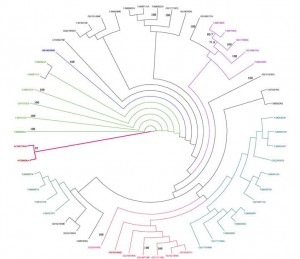No we are not talking about the State of Origin prop who unknowingly took to the field with swine flu. Rather the influenza virus sweeping the world and where it actually comes from.
As you may recall, there was some front-page confusion in the New Zealand media last week after Dr Gus Kousoulas, a scientist at Louisiana State University was quoted as saying swine flu originally came from New Zealand or China. When the SMC followed up with Dr Kousoulas he claimed he was misquoted by a newspaper reporter in Louisiana, a claim the reporter disputes.
Anyway, with that bogus story now last week’s fish and chip wrappings, where did swine flu actually come from? Well, that is exactly what Dr Kousoulas and his colleagues at the Division of Biotechnology and Molecular Medicine are actually trying to find out. How do you trace a virus? Well, as an article on the BIOMMED website explains, by analysing and comparing isolates taken from sequences submitted from around the world to Genbank, the influenza genome sequencing project.
Some isolates from New Zealand are featured on this “evolutionary tree” based on Genbank data submitted so far. But as BIOMMED is careful to point out: “The current tree is based on the HA gene alone from a few selected strains. Consequently, it is difficult to establish the origin of the 2009 swine flu outbreak. A larger, more inclusive dataset will be useful to delineate the evolution and spread of the H1N1 flu virus. Additional comparative analysis using the neuraminidase gene (NA) and other genes from the same H1N1 isolates may help establish an evolutionary pattern”.
If scientists are yet to pinpoint geographically where swine flu sprung from, they’ve already figured out pretty much the genetic make-up of A(H1N1) as this Economist article points out:
“In a paper published in Science, they confirm that the closest genetic relatives of the new virus are swine-flu strains from both North America and Eurasia. The virus is made of eight gene segments of known provenance but which have not previously been seen in this combination. The genetic material in them is indeed a hotchpotch derived from avian, human and swine sources, but all eight segments come most recently from pigs.”
